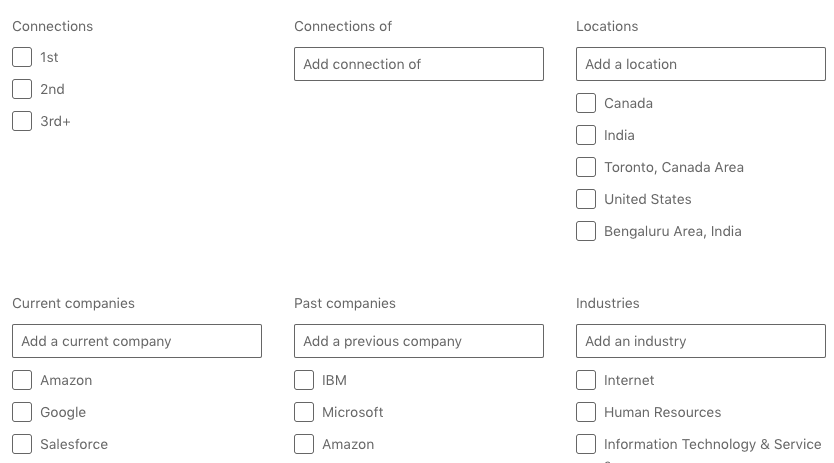How to source fantastic candidates
Most people seem to think recruiters have mystical powers that make candidates just pop out of the ether with resumés in hand. While there are definitely some recruiting skills that are honed through repetition, a lot of the basics can be applied by anyone.
Here I’ll run you through a basic process to help you find and engage with candidates who are perfect for your role. There are three key categories: where to source talent, how to find the candidates in these places and how to engage them.
Where to source candidates
Maximizing existing candidate pools
Trust me on this one: You will want to start your own in-house database of candidates as soon as you begin interviewing, because the interviews will all start to blend together very quickly!
Your database can begin life as a simple spreadsheet with a tab for each role you are interview. I recommend recording each candidate’s name and contact details, and notes from the interview (both positive and negative). This way, you will be able to save yourself time in the future, as well as find that great person you interviewed last year but didn’t have the right role available at the time.
As your hiring ramps up, ideally when you have multiple hiring managers and lots of open roles for which you need to keep track, it’s wise to invest in an applicant tracking system (ATS) to do this same thing at scale. Some good starting options are BambooHR (which also includes some HR functionality as well), JazzHR, Humi and JungoHR.
With either your spreadsheet or ATS, you will be able to look back to find candidates who might add value to your business as your needs grow and change.
Job boards
Using a job board like Indeed, Monster or CareerBuilder isn’t the silver bullet it may seem to be. High-calibre talent, especially technical or engineering talent, is so in demand that these candidates have no need for job boards anymore.
Generally, job boards make sense if you are hiring for non-specialized roles at a high volume. For example, if you need to staff a call centre or warehouse, then posting on job boards is a great option. However, if you are looking for a senior JavaScript developer, you will be waiting a long time for the right candidate to proactively apply.
Without doubt, LinkedIn is the single most powerful tool for finding candidates. With over half a billion users (!) there is no better social platform for finding and engaging professionals.
While there is a lot of great functionality that is unlocked by paying for a Recruiter or Recruiter Lite level licence, the cost is prohibitive. But by using a Boolean search (more details below) in regular LinkedIn, you can still find great candidates.
You can either type your Boolean string straight into the search bar or pop in a search term and then click “All Filters” on the results page to get access to different fields (see screenshot below).


LinkedIn is also a great platform for expanding your network, so don’t be shy about posting content or adding connections as you build your presence within your local talent market.
How to find your candidates
Keywords
The starting point for any proactive search is identifying your keywords. These will stem from the work you did around defining the role; start with your “day one” skills and build a list of synonyms for each skill. The goal at this stage is to be as creative and divergent as possible to create a list that will unearth great profiles.
You might be looking for a “manager,” but the ideal candidate might be a “coach,” “leader,” “director,” “head of” or even an “inspirer of people.” Bring an open mind and think broadly and creatively.
Boolean strings
Boolean strings are a way to combine the keywords you just created with operator terms (AND, OR and NOT) to create more accurate and relevant searches. Most search bars will allow these, and you can quickly create very targeted short lists of candidates to review.
At this point, I suggest pausing and checking out this one–page summary of Boolean basics.
By using basic Boolean strings, you will be able to make more effective use of LinkedIn, Google or any other site with a search function.
For example, let’s say you want to hire a JavaScript developer who has worked on AWS but not Microsoft Azure. You could easily write:
(Javascript OR JS OR Node.js OR Angular OR React OR Vue.js OR Ember.js) AND “AWS” NOT (Azure OR Microsoft)
I pulled these JavaScript keywords directly from a Google search and applied the basic Boolean logic. I’ve broken down this search below to explain it.
-
- (Javascript OR JS OR Node.js OR Angular OR React OR Vue.js OR Ember.js)
This tells the computer to find any one of these terms in someone’s profile. Once it finds one of those terms, it progresses to step 2. If it doesn’t find one, it will not add the profile to the results page.
-
- AND “AWS”
From all the profiles that had one of the terms in step 1, it will now search for “AWS.” If it finds AWS, it will move to step 3; if not, the profile will be disregarded.
-
- NOT (Azure OR Microsoft)
Finally, if the computer sees either “Azure” or “Microsoft,” it will disregard the profile.
By following this logic, you can quickly sift out lots of irrelevant pages. This is also hugely useful in day-to-day life, when you are searching for a specific product, piece of information or targeted news article.
How to engage with your candidates
Regardless of how you find the candidate, it’s important to create compelling messaging that allows the candidate to understand why this is a great opportunity for them. Below is a basic messaging structure to help you nail the perfect first impression.
-
- Correctly spell their name. (Would you respond if someone got this wrong?)
- Outline what it is about their profile that stood out to you while you were searching.
- Always assume candidates have never heard of your company—explain your mission and vision briefly.
- Outline how this role contributes to the mission and vision.
- Offer a call or coffee to explain more about the role.
At Opencare, we have had some tremendous success in creating video content to help talk about the role and mission. It really helps to personalize the experience for the candidate and create a connection with you and the company.
You should also look back at messages you have previously received from recruiters or sales teams and pull out things that stood out to you. What did the recruiter include in their message that got you to take the call? Could you adapt or modify it to make your message more compelling?
Ultimately, you want to think about writing a message that will resonate really well with your ideal candidate rather than a bland, generic one anyone could write.
When should you hire an in-house recruiter?
In the early stages of building your company, recruiting should take up a significant amount of your time. It is fundamentally the most important investment you can make to help your company and product scale up.
There are a couple of major indicators that you might be ready for an in-house recruiter: consistent hiring criteria, spending much of your time hiring and sufficient financing.
Make no mistake—hiring is a skill. As such, you will need practice to get good at it. Your first few hires will be bumpy experiences, and you’ll make some great and some awful hiring decisions. But once you have found a groove, whereby you can clearly articulate what attributes you want to find in candidates you’re ready to ramp up your hiring through a recruiter.
If you are spending more than two-thirds of your time on hiring and related activities, then you should really consider hiring an in-house recruiter to help do some of the heavy lifting. You will still need to stay heavily engaged to ensure you are upholding the standards you want to see, but the recruiter will be able to engage candidates more effectively and quickly.
Finally, it only makes sense to add a recruiter if you have the finances to support a significant number of hires in the coming year. A “significant” number varies among industries, but somewhere between 15 and 25 new hires is a reasonable expectation.
What about recruitment agencies?
Recruitment agencies are a great option for augmenting your recruitment efforts for targeted, high-impact roles that will help shape the future of your company.
Typically, these agencies will charge 20% to 25% of a candidate’s first-year salary, which means a significant chunk of cash out of your pocket.
However, if you have just landed a multi-million-dollar account and suddenly need a technical architect to build out your product, then perhaps that’s a wise investment.
Spend some time chatting with a couple of agencies. Select the one that is most invested in your company and brought some insights to your conversation. Great agencies are tapped into their specific markets (for example, technical, executive or sales talent) and will be able to partner with you to help you make the best decision.
Key questions to ask the recruitment agency:
- Who are the major competitors for this talent in the market?
- What’s the salary range for this position?
- What companies have you successfully made placements with recently? Can you introduce me to the CEOs so I can ask about their experiences?


